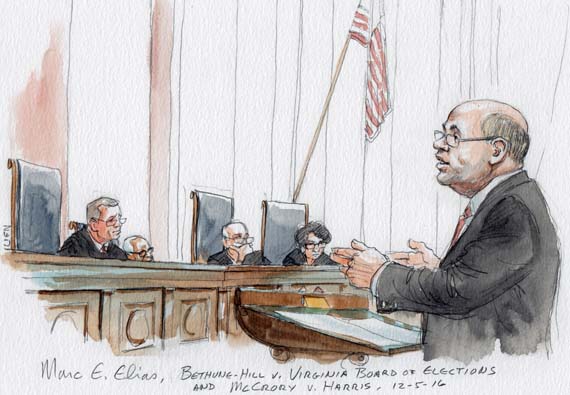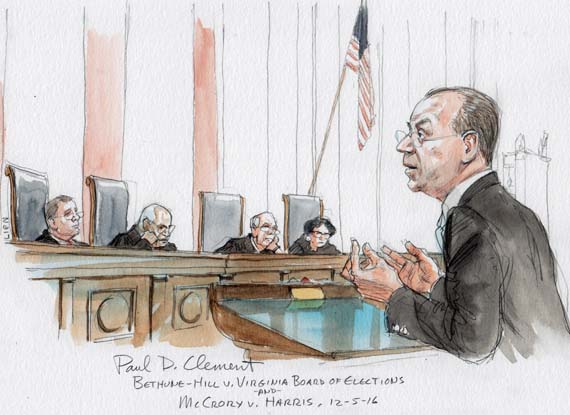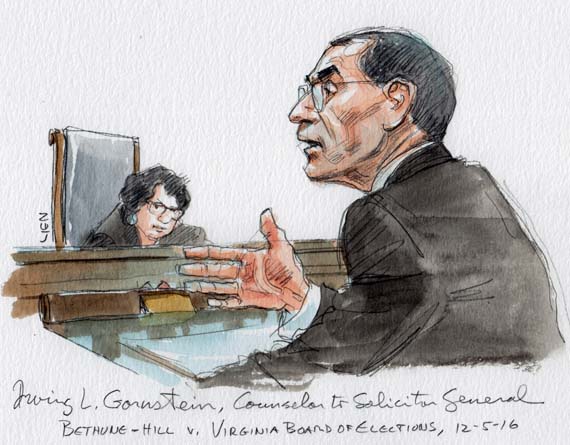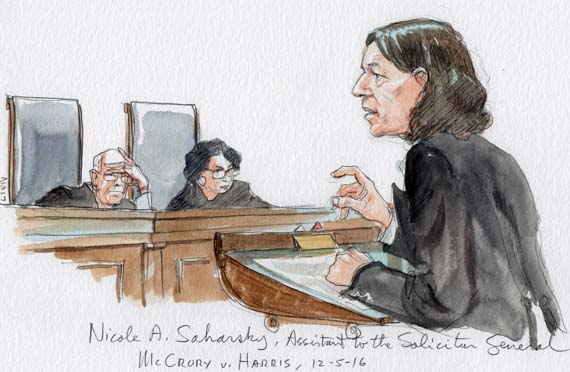Argument analysis: Lots of questions, no easy answers in redistricting cases

on Dec 5, 2016 at 10:42 pm
“It is a very tough matter,” observed Justice Stephen Breyer, summarizing the questions with which the justices were grappling today. Federal law permits (and sometimes requires) states to consider race when drawing district lines, to create legislative districts in which a majority of voters are members of a minority group, but at the same time the Constitution bars states from making race the predominant factor when drawing districts. “No one,” Breyer continued, “seems to have a good answer to” the dilemma facing the Supreme Court – how courts should determine when the use of race becomes sufficiently pervasive that it crosses over to become unconstitutional racial gerrymandering, particularly when race correlates closely with political party. If there was a consensus on the court this morning after roughly two hours of oral arguments, it may have been this: Justices of all ideological stripes are tired of redistricting cases, and they would really prefer to leave the business of drawing and reviewing legislative maps to the legislature. To that end, the justices seemed to be considering issuing opinions that might not immediately resolve the two cases before them, but which could give more concrete guidance to courts reviewing future racial gerrymandering claims. Whether they can coalesce around such rulings remains to be seen.
It was a somewhat unusual day of oral arguments at the court. Although the two cases, Bethune-Hill v. Virginia State Board of Elections and McCrory v. Harris, present similar and sometimes overlapping issues, they were argued separately – but with the same two lawyers representing the challengers to the districting maps and the state officials defending the maps, respectively.
First up today was Bethune-Hill, a challenge to the redistricting maps that were drawn for state elections in Virginia after the 2010 census. The plaintiffs in the case argue that, by drawing 12 districts, each with a target of an African-American population of 55 percent, the architects of the plan engaged in racial gerrymandering. A three-judge district court ruled that, even if the map’s architects had used a fixed target of African-American voters in each district, the plaintiffs would have to show (but had not shown) an “actual conflict between traditional redistricting criteria and race,” in which race had prevailed over those traditional criteria.
Arguing on behalf of the challengers, attorney Marc Elias told the justices that the lower court had created a new legal standard “out of whole cloth,” conferring judicial immunity on districts as long as they are “visually appealing” – that is, consistent with traditional redistricting criteria, which look (among other things) at a district’s geographic shape.

Marc E. Elias (Art Lien)
But Elias quickly ran into tough questions from Chief Justice John Roberts, who pressed Elias to explain how courts should assess whether race was the “predominant” factor in creating a district. Roberts suggested that it is easy to imagine a situation in which no one factor dominates the redistricting analysis. But a test like the one used by the district court in the Virginia case, Roberts pointed out, would make it easier to assess whether a factor was predominant: Courts would look first at whether there is a conflict between race and the traditional criteria; if so, “whatever [factor] trumps the other, that’s the predominant one.”
Breyer asked Elias how else courts could make the determination that race was the predominant factor in drawing the Virginia districts. What evidence do you have, Breyer queried, that race “trumped” the traditional redistricting factors? Breyer noted that in a recent challenge to legislative maps in Alabama (which, he lamented, he had hoped “would end these cases in this court, which it certainly doesn’t seem to have done”), thousands of voters had been moved into the districts then under review, but only a dozen or so of those voters had been white.
But notably for the challengers, Justice Anthony Kennedy – whose vote they would almost certainly need to prevail – appeared sympathetic to their position. He asked Paul Clement, who represented the state officials defending the districts, about a scenario involving two conventional-looking districts, in which legislators choose one of those districts because it has more minority voters. “Is that predominance? ” he inquired. When Clement responded that it would not be, Kennedy told him, “I have problems with that.” Kennedy explained that “predominance is designed to measure intent when there are multiple causes,” and in his hypothetical, he noted, “the principal motivating factor was race.”

Paul D. Clement (Art Lien)
Clement was unfazed. “Predominant,” he told the court, means “over something else,” such as traditional districting criteria. He asserted that the challengers’ entire case that race was the predominant factor in drawing the Virginia districts was based solely on the 55-percent target. By contrast, he stressed, “we had extraordinarily good evidence” that race was not in fact the predominant factor. And he cautioned the court about the more expansive implications of ruling for the challengers, emphasizing that whatever rule it eventually adopts will sweep broadly, applying not just to “relatively sophisticated legislatures” but also to smaller entities, such as school boards and sewer districts, with fewer resources.
Some justices seemed amenable to a middle ground, advanced by the federal government: Even if a bright-line rule requiring challengers to show a conflict between traditional redistricting criteria and race, in which race had prevailed, is not appropriate, the challengers will still need to show a conflict “in the vast majority of cases.”

Irving L. Gornstein, Counselor to the Solicitor General (arguing for the federal government in Bethune-Hill v. Virginia State Board of Elections) (Art Lien)
For Justice Samuel Alito, it seemed that this standard wouldn’t go far enough. He characterized the dilemma before the court as “very, very complicated.” State legislatures, he noted, have to do a lot of redistricting in a very short time. Although there may be no way around it, he acknowledged, he wondered whether this standard too would simply be “an invitation for litigation.”
Justice Elena Kagan seemed more receptive. She told Clement that the “real difference” between the standard proffered by state officials and the one advanced by the federal government is that, under the state officials’ standard, courts would not look at race at all as long as the traditional redistricting criteria – such as a conventional shape – were met.
Clement responded that the difference between the two standards occurs in the “real world.” Given the high stakes for redistricting, he told the court, even the federal government’s standard would result in more lawsuits, notwithstanding the federal government’s assurances to the contrary.
The justices grappled with another vexing issue in the Virginia case: if the lower court did apply an overly restrictive standard, what should the Supreme Court do about it? Justice Ruth Bader Ginsburg (who sounded as if she had recovered from the bad cold she had last week) suggested that the justices should vacate the decision below and send the case back to the lower court, with an instruction that race can be a predominant factor even if there is no conflict with traditional redistricting principles.
Elias told the court that it did not need to send the entire case back; rather, the justices could simply go ahead and strike down some of the challenged districts, in which – at least in his view – it was clear that race was the predominant factor behind the map.
Chief Justice John Roberts indicated, however, that such a determination might be difficult to make for just a few districts. For example, he said, if the court were to rule that a district can’t pull in a group of voters, then “you’ve got to push them back, and now all of a sudden that other district has an issue.”
And Breyer suggested that, even if the lower court had used the wrong test to evaluate whether race was the predominant factor, it might not make a difference in the ultimate outcome. This is particularly true, Breyer continued, when you factor in the need to give the state some leeway.
The second hour focused on two congressional districts in North Carolina, known as NC-1 and NC-12. A three-judge district court struck down both districts, concluding that they had been illegally packed with African-American voters, which in turn reduced the influence of African-American voters elsewhere.

Nicole Saharsky, Assistant to the Solicitor General (arguing for the federal government in McCrory v. Harris) (Art Lien)
Defending the districts, Clement asserted that one of the districts – NC-12, which the district court characterized as a “textbook example of racial gerrymandering” – was in fact drawn with “avowedly” political motives: to pack Democrats into districts and thereby maximize the number of Republican-friendly districts. When race and politics are so closely correlated, he contended, challengers must show another way that the legislature “could have accomplished its political goals without a comparable emphasis on race.” That requirement, he continued, stems from the court’s 1999 decision upholding an earlier iteration of NC-12 against a racial gerrymandering claim.
Kagan was skeptical of Clement’s suggestion that the plaintiffs challenging a redistricting plan must be required to present their own maps. She posited a scenario in which the challengers have direct evidence that a redistricting map was based on race; do they still need to offer their own maps? And, she added, asking plaintiffs to submit their own maps can impose a significant burden.
Here too Clement stood his ground. If there is substantial evidence that the redistricting map was based on race, he suggested, it shouldn’t be that hard to formulate an alternative map. And such a rule would both respect the sovereignty of the state legislatures that created the challenged maps and be far easier for courts to administer in the future.
Justice Sonia Sotomayor (who sounded as though she had caught Ginsburg’s cold and was relatively quiet today) was also dubious. Even if the court were to require alternative maps, she predicted, the state officials defending a map would still always be able to come up with political explanations for why the alternative maps were not feasible. “It’s impossible to ask a plaintiff to come up with a race-neutral map in light of the entire region,” she concluded.
It would be a “pretty big thing” to say that the legislature was not telling the truth about its motives in drawing a districting map. And so, Clement maintained, the court needed to provide some kind of mechanism to determine whether a districting map was driven by race or politics, such as requiring an alternative map.
Elias agreed that an alternative map was one way to show that a districting map was based on race, but it was not the only way, he emphasized. There should be no need to use circumstantial evidence like an alternative map to prove what plaintiffs can show directly.
But here Elias found pushback from Alito. It makes sense to ask the challengers to draw an alternative map, he told Elias, because it is impossible for state officials to prove a negative. And Alito seemed to agree, at least to a certain extent, with Breyer’s suggestion of another middle ground – that, even if the challengers do not need to provide their own alternative map, they would need to provide some kind of evidence that the maps were based on race.
A few justices also broached the possibility that the federal courts should not have considered the challengers’ claims at all, because a state court in North Carolina had already upheld the same districts. Ginsburg, perhaps the justice most likely to home in on potential procedural flaws in a case, observed that the challengers were urging the justices to apply a low bar to the federal district court’s ruling, striking it down only if the justices concluded that the ruling was clearly wrong. But if the state court case upholding the districts were before the justices instead, she pointed out, then those findings would also be affirmed unless they were clearly wrong.
Elias pushed back, telling the justices that the “clear error” standard applies to whatever case is before the justices. But Ginsburg’s point found traction with Kennedy, who told Elias that it was simply the “luck of the draw” that the federal case made it to the Supreme Court before the state case. Roberts and Alito similarly seemed disinclined to go forward, as Alito put it, “as if” the state case had “never occurred.”
The court’s eventual ruling could be a complicated one. The justices could, for example, uphold or strike down some of the challenged districts, or they could send both cases back to the lower courts for further consideration. But however they rule, it is unlikely (much to the chagrin of most justices) to be the last word on racial gerrymandering. A decision in the case is expected by summer.


